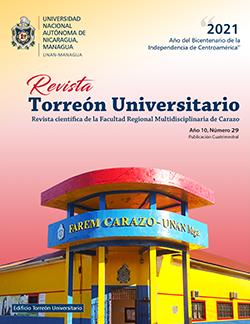Conocimiento de organismos bióticos acuáticos heterotróficos (macroinvertebrados) acumulados en las capas sedimentarias del Lago Cocibolca de los últimos 100 años
DOI:
https://doi.org/10.5377/rtu.v10i29.12742Palabras clave:
paleolimnología, macroinvertebrados, sedimentos, proxies biológicosResumen
El lago Cocibolca es el ecosistema de agua dulce más grande de América Central y recientemente ha ganado la atención de la comunidad científica internacional ante la construcción planeada del canal interoceánico que potencialmente podría cruzar e impactar este sistema. Este estudio pretende realizar una reconstrucción cualitativa utilizando proxies biológicos heterotróficos (macroinvertebrados) y su relación con eventos naturales extremos conocidos, así como actividades antropogénicas claves. A través del análisis de 210Pb se analizaron dos núcleos de alta resolución del lago Cocibolca, para el último siglo ~100 años, los cuales fueron recolectadas: uno en la zona oriental (PLNI), y otro cerca de la Isla de Ometepe (PLNII). Relativo a los chironomidos, se observó un bajo número de restos fósiles, los que concuerdan con los registros limnológicos del Lago, donde esta comunidad exhibe bajas proporciones. Las altas tasa de erosión y sedimentación principalmente en la cuenca sur, aportan al sistema abundante material rico en nutrientes, los que modifican la productividad del ecosistema. En consecuencia, la comunidad de ensamblajes bénticos se ha transformado, favoreciendo a las especies oportunistas y mejor adaptadas a los eventos climatológicos extremos que suman a acrecentar los problemas de enriquecimiento, anudado con las actividades antrópicas que siguen generando cambios y avances en el estado trófico del lago Cocibolca.
Descargas
391
HTML 197
VISOR 0
PDF (English) 97
HTML (English) 73
Citas
Appleby, P. (1998). Dating recent sediment by 210Pb: problems and solutions. Stuk A-145, 7–24.
Cummins K. (1984). An Introduction to the Aquatic Insects of North America. 702 pags. Second Edition. ISBN 0-8403-3180-0. USA.
Ekstrand, S. et al., (2009). Twinning Europeand and Latin-American river basins for research enabling sustainable water resources management (TWINLATIN).
Henrikson, L. et al., (1982), The impact of acidification on Chironomidae (Diptera) as indicated by subfossil stratification. Hydrobiologia 86, 223–229. https://doi.org/10.1007/BF00006140.
International Bank (2013). Prioridades de Política e Inversión Para Reducir la Degradación Ambiental de la Cuenca del Lago de Nicaragua (Cocibolca). 1818 H Street NWWashington DC 20433. 118 pág.
INETER (2006). Cartographic database of the pacific of Nicaragua, scale 1:50000, 3rd Ed. (National basin and sub-basin shapefiles, and also topographic sheet 2951-1).
Messaferro, J. et al., 2014. Paleobioindicadores del fin del mundo: Ostrácodos y quironómidos del extremo sur de Sudamérica en ambientes lacustres cuaternarios. Latin American Journal of Sedimentology and basin analysis. Vol. 21 (2), 97 – 117.
Messaferro, J et al., 2014. Palaeogeography, Palaeoclimatology, Palaeoecology. Quantifying climate change in Huelmo mire (Chile, Northwestern Patagonia) during the last glacial termination using a newly developed chironomid-based temperatura model. Elsevier. Vol. 399, pages 214-224.
Montenegro, S. (2003). Lake Cocibolca / Nicaragua. In World Lake Basin Management Initiative (p. 29). Saint Michael’s College, Vermont: The Regional Workshop for Europe, Central Asia & the Americas, LAKENET.
NOAA (2017). Historical hurricane tracker tool. Retrieved June 1, 2017, from http://origin.cpc.ncep.noaa.gov/products/analysis_monitoring/ensostuff/ONI_v5.php, accesed in 2016/2017
Smol, J. (2001). Tracking Environmental change using lake sediments. Volume 4: Zoological Indicators.
Tallberg, P et al., 1999. Seasonal succession of phytoplankton and zooplankton along a trophic gradient in a eutrophic lake – implications for food web management. Hydrobiologia 412, 81-94. http://doi.org/10.1023/A:1003804417039
Wu, J. et al., (2016). Chironomid-based reconstruction of late-Holocene climate and environmental change for southern Pacific Costa Rica. The Holocen 1–12. Reprints and permissions: sagepub.co.uk/journalsPermissions.nav. DOI: 10.1177/0959683616652702. hol.sagepub.com
Descargas
Publicado
Cómo citar
Número
Sección
Licencia
Derechos de autor 2021 Universidad Nacional Autónoma de Nicaragua, Managua

Esta obra está bajo una licencia internacional Creative Commons Atribución-NoComercial-SinDerivadas 4.0.
Los autores que publican en esta revista están de acuerdo con los siguientes términos.
- El autor o los autores de los artículos, ensayos o investigaciones conceden a la Universidad Nacional Autónoma de Nicaragua, Managua (UNAN-Managua) los derechos de edición (copyright) del trabajo enviado, por consiguiente la Universidad cuenta con el derecho exclusivo para publicar el artículo durante el periodo completo de los derechos de autor.
- Estos derechos de autor/ autores autorizan a la Revista Torreón Universitario y a la Universidad editar y divulgar/publicar el artículo en dicha Revista, incluyendo reproducción impresa y electrónica, el almacenamiento, recuperación y cualquier otro tipo de publicación, y fuentes de información secundaria como servicios de resúmenes y bases de datos, así mismo la facultan a proteger el artículo contra el uso no autorizado para su difusión por medios impresos o electrónicos (PDF, HTML, EPUB, XML u otros).
Licencia para el uso del contenido
La revista hace uso de la Licencia Creative Commons Atribución-NoComercial-SinDerivar 4.0 Internacional.
Bajo esta declaración:

Este revista está sujeta a una licencia de Creative Commons Reconocimiento-NoComercial-SinObraDerivada 4.0 Internacional. Puede ser copiada, distribuida y transmitida públicamente siempre y cuando se cite al autor y la fuente (Revista Torreón Universitario), no debe modificarse ni utilizarse con ningún fin comercial. La licencia completa se puede consultar en http://creativecommons.org/licenses/by-nc-nd/4.0/.



